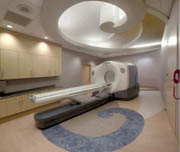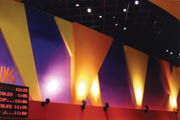This year's contest was prominently advertised in trade magazines, via postcards sent to select AIA members and on the association's Web site. In other words, we carpeted North America with calls for entry.
Over the last few months, the entries have been received and judged, and now the results for the Gypsum Association's 2004 Excellence in Gypsum Board Design and Construction Awards Program are in. But before announcing the winners, some background information on how the competition is conducted may prove insightful.
The entries were submitted by team leaders, typically an individual from the contracting or design firm that coordinated the project or installed the gypsum board. The teams usually consist of the design firm, the general contractor and the drywall contractor. Once the winners from the residential and non-residential categories are selected, and several rounds of paperwork are executed, each winning entry's team leader receives a check for $3,000 and each company in the team receives a plaque that permanently recognizes their achievement. The team members of the projects receiving honorable mention also receive a commemorative plaque.
To judge the entries, we convened a panel of three industry veterans with architectural and construction expertise who evaluated each offering for the unusual use of gypsum products (that is using gypsum board where another building material would normally be used), uniqueness of design and quality of the finished project. The judges evaluated the entries primarily by the photographs provided and any clarifying information submitted with the entry; however, references to the architects and contractors involved and the project locations were blocked out to ensure that the judges were not inadvertently influenced by such information. For this year's competition, the judges selected a winner in both the residential and non-residential categories. Two projects in the non-residential category were also chosen for honorable mention.

Residential category:
The 2004 winner in the residential category was the Gillispie Residence Project, in Camarillo, Calif. The project's designer, contractor and drywall contractor was Don Gillispie Drywall, also of Camarillo. This project featured ornate ceilings in two large rooms that used gypsum board that were integrated with the room's lighting. Each ceiling used several lighting sources in combination with sculpted gypsum board diffusers and reflective surfaces to create a palette of lighting variations ranging from a low-level glow, to subtle mood lighting, to full illumination. The many faces of the articulated ceiling surfaces also cast an equally interesting array of shadows, depending upon which combination of lighting sources was used. This takes full advantage of the gypsum features' ornamental properties and further enhances the intended mood.
Non-residential category:
The 2004 winner in the non-residential category was the Dickinson & Gooding Center for Early Detection at Scripps Center for Integrative Medicine Project, in La Jolla, Calif. The project's architecture firm was Schmidt Scanlon Gordon of San Diego; the project's general contractor was Turner Construction, of San Diego; and the project's drywall contractor was Raymond Interiors, also from the same city.The vision of the architect on this project was to create an environment using forms, dimensions and colors to reassure the mind and soothe the spirit. Using environmental research that shows a link between a person's physiological wellness and an innate need for nature, the center's architecture was designed to elicit a calm, peaceful state of mind. According to the architect, this is largely achieved by using as its template "the Golden Mean, a natural sacred geometric proportion that is the basis of the center's structural and interior design."
Gypsum board features were used throughout this project to visually occupy and soothe patients in the Scripps Center. The lobby area uses gypsum board features to create soffits that visually direct patients and visitors to the sky-lit reception area. Curved gypsum board walls and ceilings direct light from skylights and indirect lighting throughout the lobby area, creating a sense of warmth and openness. Curved gypsum board walls, with sloped upper edges, create a seashell-shaped patient seating area. Curved gypsum board partitions provide patients with privacy screens, while creating free flowing functional spaces in the reception and waiting areas. A holographic prism in the reception area's skylight uses sunlight to create a rainbow of colors that are projected and displayed on the surrounding gypsum board surfaces.
In the scanner room, a shell-shaped gypsum board feature on the ceiling, along with a curved soffit that incorporates fiber-optic lighting, provides a special lightshow to patients during the testing process. To further enhance the attempt to create a non-clinical setting, the hallways continue the curved soffit theme and the examination rooms use curved gypsum ceilings that allow the incorporation of full height exterior windows.

Honorable mentions:
Receiving honorable mention was the Orange County Museum of Art project in Newport Beach, Calif. The project's architecture firm was Bauer and Wiley Architects, also of Newport Beach; the project's general contractor was the Howard Building Corp., of Costa Mesa, Calif.; and the project's drywall contractor was Quality Production Services, of Redondo Beach, Calif.
The challenge on this project was to renovate a space that had originally been an enclosed patio, which consisted of brick pavers, uneven concrete walls and a glass curtainwall. The renovation had to economically address the problems of inadequate lighting, glare and deafening noise conditions, while providing suitable surfaces for displaying works of art. One major component of the solution was a carefully devised system of floating, acoustically designed, perforated gypsum board panels to cover the uneven concrete walls. Aside from masking the irregular concrete, the panels provided both an innovative light-reflecting look and a means of noise reduction by absorbing sound that previously had been reflected off several of the hard surfaces in the space.

On this project, Century Theatres sought to continue its corporate theme of presenting visually exciting entrances using unusual multi-colored shapes and designs on the interior walls of its theatres. This theatre's lobby area used several prominent features to meet that goal. One of those features uses miniature lights that carefully protrude through the gypsum board over the entire wall surface to create the illusion of stars in a night sky. The lobby also features several floating gypsum eyebrows above the lobby's columns and a protruding star directly above the arcade entrance that was hand crafted of steel studs and gypsum board. The lobby's boldest features are the light beam shapes on many walls that reflect spotlights to create the effect of searchlights shining through the night sky. Below the search light beams is a gypsum board fascia hiding red neon lights that simulate a sunset's glow.
Additional photos of the winning projects as well as photos of the other entries submitted to the program will be posted on the Gypsum Association's Web site at www.gypsum.org. The posted photos will be replaced periodically, so visit the site to see the different entries and jobs that use drywall in challenging ways.


Report Abusive Comment